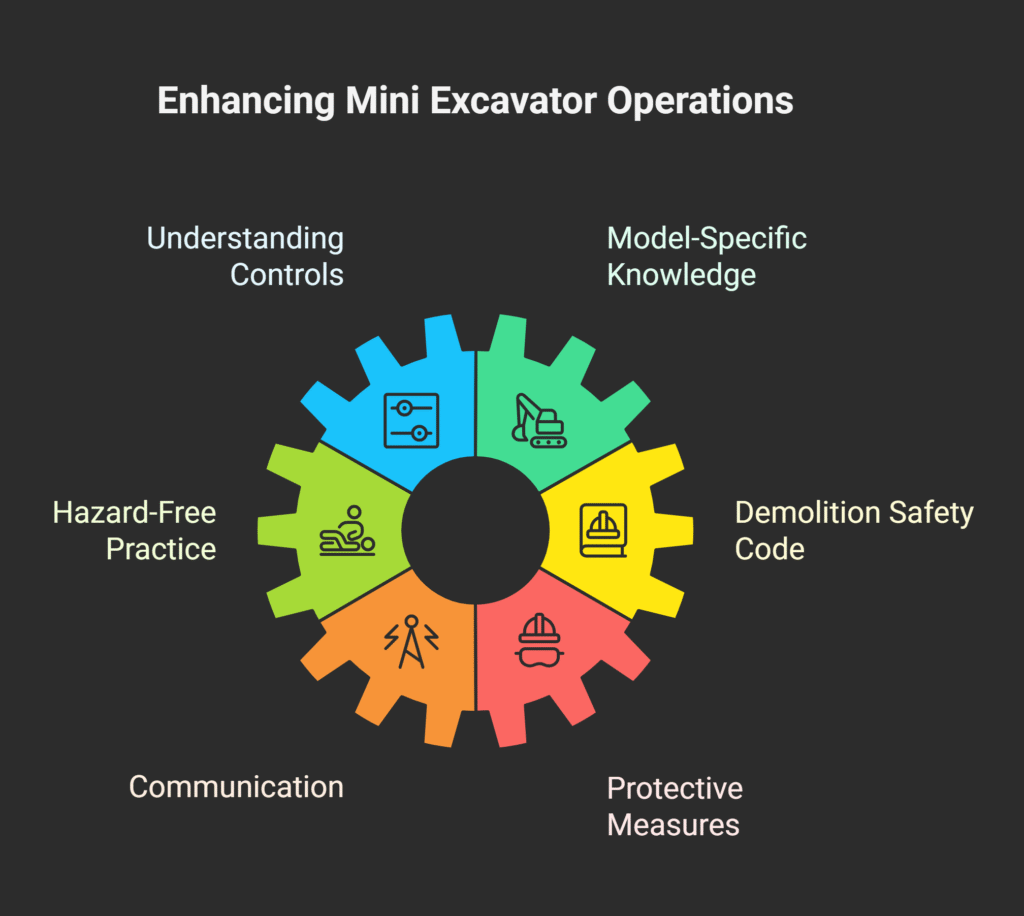Maximizing Efficiency with Mini Excavators
Mini excavators have grown largely popular in the construction and landscaping fields thanks to their multifunctionality and time-saving features. These small and mobile machines can be easily used for a bunch of different tasks, which is very suitable for projects with restricted areas.
One of the biggest advantages that mini excavators possess is their aptitude for maneuvering in constrained spaces. Unlike their counterparts in generally larger sizes, mini excavators can be comfortably driven through narrow alleys, backyards, and urban areas, which in turn enables one to have access to places that otherwise would not have been reached.
This feature is very useful, in particular, with residential projects as the availability of space is a common limitation affecting the choice of equipment. Apart from being of a small size, mini excavators are also known to have a high power-to-weight ratio.
Quite a few of the lightweight mini excavators are equipped with powerful engines sufficient to drive the hydraulics needed for excavating, lifting, and leveling works. The meaning of this is that drivers can get to work and carry out quite a lot without requiring more or big machines.
Additionally, mini-excavators are often the ones that consume less fuel than their more massive models. Therefore, they are also less expensive to operate over an extended period. Moreover, their lower weight creates less harm to the ground, which is very beneficial in terms of the sensitive nature of such environment as, for instance, gardens or a historical location still in use.
Key Takeaways
- Mini excavators definitely embody the theme of super mobility and versatility in tight and narrow spaces therefore, they are a perfect fit for various construction and landscaping projects that need more agility and speed.
- The choice of the ideal mini excavator for the task should be based on the size of the job site, the dimensions and physical dimensions of the trenches, and the kind of terrain being worked on.
- Good maintenance and proper care of mini excavators, which include regular checks, lubrication, and cleaning can help prolong the life of the equipment and keep it in top condition.
- By connecting and using accessories such as buckets, hammers, and augers, more use of the mini excavators and versatility is possible, that is, the range of tasks designed for the same machine can be expanded.
- The safe and efficient use of mini excavators is made possible through good operating practices such as training of operators, safety regulations observance, only in that case, equipment checks to make sure that good health is maintained.
Choosing the Right Mini Excavator for the Job
Assessing the Project Scope
Every model has different working weights, digging depths, and reaches. As an example, if the project is about a deep trench or a lot of excavation work, a mini-excavator with a longer arm and bigger digging depth is needed. On the other hand, if the purpose is for light duty, such as small demolition or yard work, a small-sized excavator may be sufficient.
Considering the Terrain
It is also important to think of the kind of terrain that will be available for the mini excavator to work on. Some models work well on rough, uneven surfaces, while others are more suitable for flat surfaces.
Evaluating Attachment Compatibility
Attachment compatibility of the machine should also be taken into account by the operators. There are different types of extra pieces for small excavators to be fitted with,
e.g., the buckets, augers, and the hydraulic breakers that could significantly increase their productivity. Operators will, therefore, be able to select the most efficient machine for their needs by understanding the specific job requirements and matching them with the capabilities of different mini excavator models.
Proper Maintenance and Care for Mini Excavators
Mini excavator maintenance is a key factor in the life expectancy and performance of the equipment. Checking the levels of liquids, inspecting the hydraulics and keeping an eye on track wear and undercarriage components should be routine care.
They should therefore follow the maintenance schedules and service intervals stated by the manufacturers. That means that the oil in the engine should be changed regularly so that it can run properly and the parts will not wear out quickly due to friction.
The combination of normal servicing and the mandatory daily checks carried out before deploying the machine should encourage peace among the operators.
This could include the search for worn out parts, the assurance of the correct functioning of the safety covers, and the tautness of attachments.
Cleaning the mini excavator is also as vital as the previous tasks since dust and other particles can gather in areas hard to reach causing resulting in mechanical issues in the future.
By instituting and sticking to a meaty maintenance plan, operators can reach out to the manufacturers for help and thus influence them to provide the service and spare parts needed, if they can service and take care of their mini excavators, they may increase the chances of the machine serving them for some more time.
Utilizing Attachments to Increase Efficiency
| Attachment Type | Efficiency Increase |
| Email Attachments | 20% |
| Document Attachments | 15% |
| Image Attachments | 10% |
One of the main selling points of a mini excavator is that it can be easily hooked up with many different kinds of attachments, which can greatly improve its adaptability and productivity on the construction site.
The most common attachments are buckets in different sizes for different excavation tasks and also for handling and transporting the materials, hydraulic thumbs that are able to pick up and carry things, and augers to make holes in the ground.
Apart from the fact that each of the attachments has its very specific function, the fact that they are also easily interchangeable allows the hydraulic excavator operator to be able to quickly adjust the task, the requirement being a different one, without any additional tools.
For instance, a utility worker can use a trenching bucket attachment to make the digging of trenches for the installation of water or gas lines or for drainage purposes very easy, quick, and efficient. Similarly, cement and asphalt surfaces can be demolished using a hydraulic breaker attachment in no time.
Without a doubt, these tools thrive on tasks of all kinds and significantly improve work productivity. Only through the use of these tools, the work can be done faster and more accurately. Consequently, the saved time and energy not only result in fewer tasks done but also in a reduction of labor costs, as it means that fewer machines will be needed on the site for the same job.

This technology is reshaping the world of education in terms of applying new contexts to digital information and incorporating reality. In this way, virtual reality will be utilized to effectively explain analog concepts, thus simplifying the process of kitchen processes, such as the ones in visual settings, to the level of comprehension of the children.
This will not only help with a visual presentation of the problem, but it will also reinforce that the concepts have been simplified and a certain level of understanding/learning made for both the students and the educators.
It will be the work of AI and creative digital tools rather than the educator to do this kind of work and will therefore occupy higher-level work with a bit more meaning to it, scene, character development, and so on.
The eventual result of this will be the ability to make a lot of the aforementioned changes and the ability, from an educational standpoint, to push toward the goal of prepping the learners for the world that is heavy in technology, e.g., machine learning, artificial intelligence, robotic process automation, etc.
Safety Considerations When Using Mini Excavators
Personal Protective Equipment (PPE)
Ensuring safety while using a mini excavator is not only for the operator but also for those who work nearby. To be able to cope with the dangers in such places, it is imperative to think about the personal protective gear.
Helmets, gloves, high-visibility jackets, and steel-capped boots are all indispensable items in the construction field because they help to lessen the danger of machinery operation significantly.
Conducting Site Assessments
Before using their machines, all operators must check for and eliminate potential hazards.
The risks may come from, e.g., overhead lines, unstable ground, or any pedestrian who is walking around the site. Awareness of these hazards is therefore essential for avoiding accidents and providing a safe work environment.
Machine Stability and Precautions
Limitations of the machine’s stability are addressed by the professionals in a comprehensive and practical way to avoid unwarranted operations on slopes or other uneven terrains.
Here, the use of stabilizers and outriggers, when the situation demands it, is encouraged as an additional way of ensuring stability on the operation ground.
Operators thus equipped with such knowledge as well as the necessary equipment to take all the necessary subsequent measures can significantly reduce the chances of an accident occurrence as they continue to operate in a safe environment.
Maximizing Efficiency Through Proper Planning and Organization
The efficient sorting of work among various sectors using mini-excavators largely depends on the planning and organization that occurs. Therefore, it is crucial to create clear plans for all projects involving such equipment, including the timeline, scope of work, and resource allocation. Predicting the necessary tools and ensuring their presence and accuracy is crucial.
The organization of the worksite significantly contributed to efficiency, closely aligning with the previously mentioned factors. Assigning the areas for such purposes as the storage of materials, the parking of equipment, and waste disposal would facilitate the next course of action.
Moreover, it is also the responsibility of operators to coordinate with the rest of the trades on the site so that meaningful collaboration can ensue and that people do not have to experience stoppages from one trade to another.
Such a concentrated effort on supply chain coordination and proper plans is likely to lead to lower costs while productivity goes to its maximum.
How to Calculate the Return on Investment for Mini Excavators
Buying a mini excavator is a fantastic source of income if the return is measured through various metrics, such as speed, cost of work, and machine multifunctionality.
The measurement of the money earned on a purchase (ROI) requires the knowledge of time and money that will be saved when a mini excavator is compared with manual labor or with the use of large machinery.
Thus, a multitasking scenario (e.g., multiple workers on one task) for an average load can much more quickly turn into a mini excavator solution, and this ultimately, over time, means reduced labor costs.
Moreover, the multi-aspect nature of mini excavators warrants their use in different projects—ranging from gardening to utility infrastructure—using them to the maximum throughout their life cycle.
Hence, operators can more easily increase their businesses’ clientele by taking up varied contracts without the need for specialized equipment.
A thorough scrutiny of these aspects paves the way for companies to buy mini excavators and know that they are positively contributing to the bottom line of their business.
